Richard Goes to Yahoo! Talking RSS and Blogging in 2005
On a sunny, cloudless day in October 2005, I visit the gleaming yellow and purple Yahoo! campus to talk RSS and blogging with the company's resident bloggers.
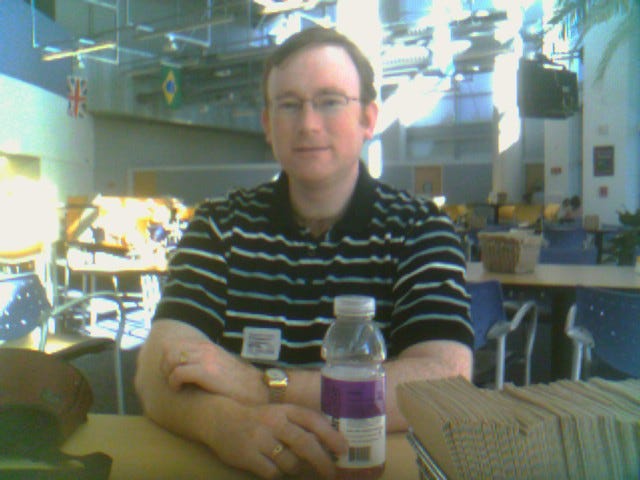
Earlier in 2005, I had made some contacts inside of Yahoo! and had begun to think about trying for a job there. One of my contacts was a search engine executive named Elizabeth Osder, and I’d told her my dream gig on the internet would be web strategist / blogger, with input into product design. She replied that I “might find a gig in strategy for a web company” and promised to ask around inside Yahoo. She also wanted to know about my experiences running ads in my RSS feeds, so there was some quid pro quo going on in these early emails.
Another helpful Yahoo employee I interacted with that year was Havi Hoffman, who worked in their newly formed social media outreach team. After I’d told her and Elizabeth that I was traveling to the US for the Web 2.0 Conference, Havi invited me to visit the Yahoo! Campus in Sunnyvale. We agreed on Monday, 10 October, the week after the conference.
When the day arrived, Havi picked me up from Mike Arrington’s house in Atherton just after 10am, and we began the twenty-minute journey to Sunnyvale. She immediately apologized for being a bit under the weather. She’d been working a lot on getting the new Yahoo! Podcasts network up and running, she explained. I told her I was just grateful she was driving me to Yahoo and that I was excited about my first trip to a Silicon Valley campus.
Havi was in her early 50s and had a ring of thick curly brown hair that framed a kind, inquisitive face. She had oval-shaped glasses, which she nervously adjusted as she asked me about my trip so far. Her voice had the tentative air of a shy person, but I also got the impression that she knew a great deal about how Silicon Valley worked. She told me that she’d lived and worked here since the Dot Com era — her first job at Yahoo had involved cataloguing web sites when it was still a directory.
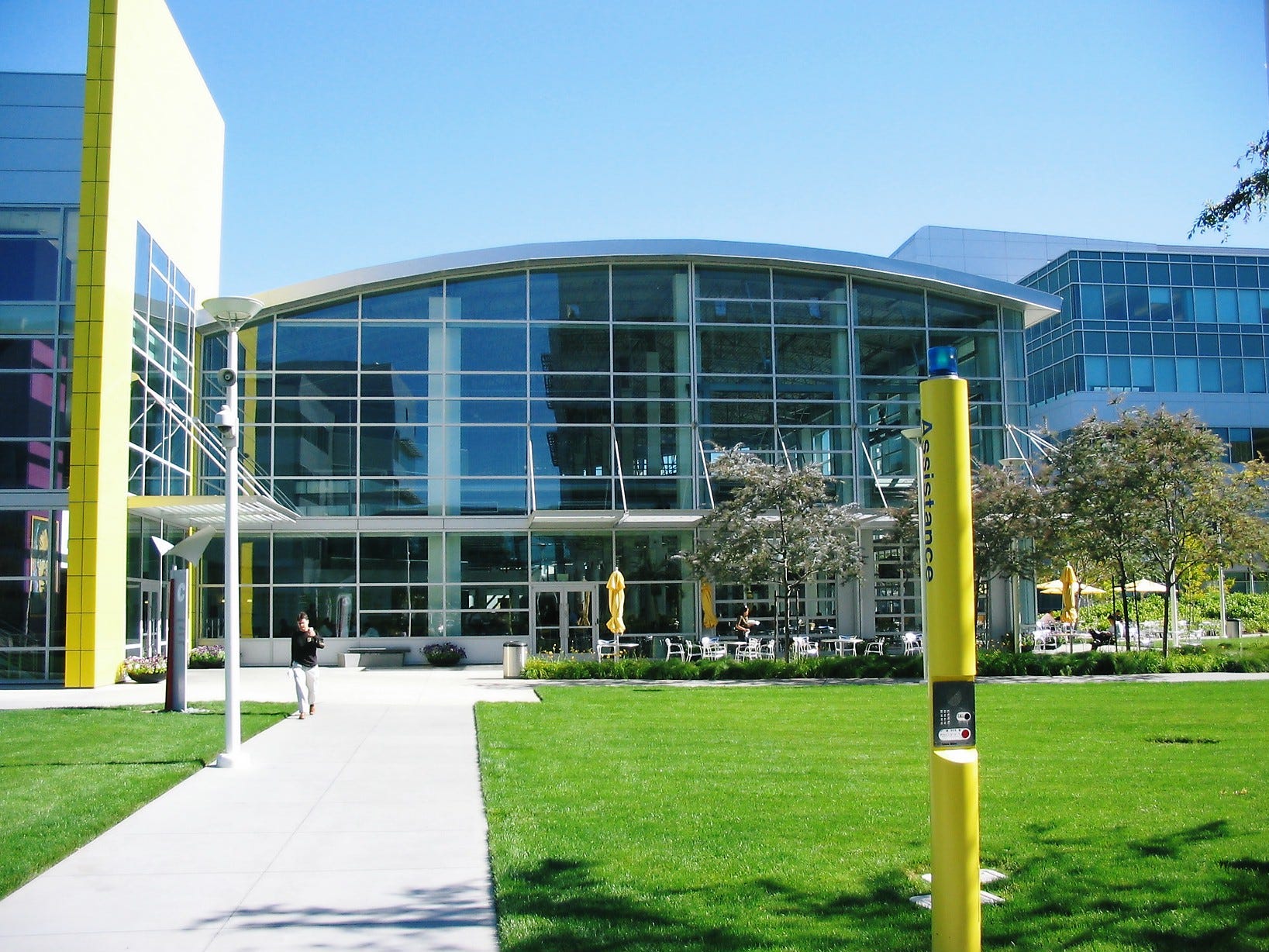
The day I visited the Yahoo! campus, October 2005.
When we arrived, I was immediately impressed by the beautiful, expansive setting of Yahoo’s headquarters. The green lawns were immaculately maintained, there were purple shrubs that matched the large purple Yahoo logo on the side of the main building, and young trees dotted the perimeters — it was the middle of autumn, so what leaves remained were a mixture of green, yellow and a mauve purple. I don’t remember seeing a single dead leaf on the ground, so both the lawns and the paths bisecting them must’ve been meticulously tidied every day.
Yahoo’s campus was still relatively new; it had opened in April 2001, in the middle of the Dot Com crash. There were four buildings, each made of concrete and encased in glass with grey metal frames. There were several large, manicured lawns between the buildings, as well as volleyball, bocce ball and basketball courts.
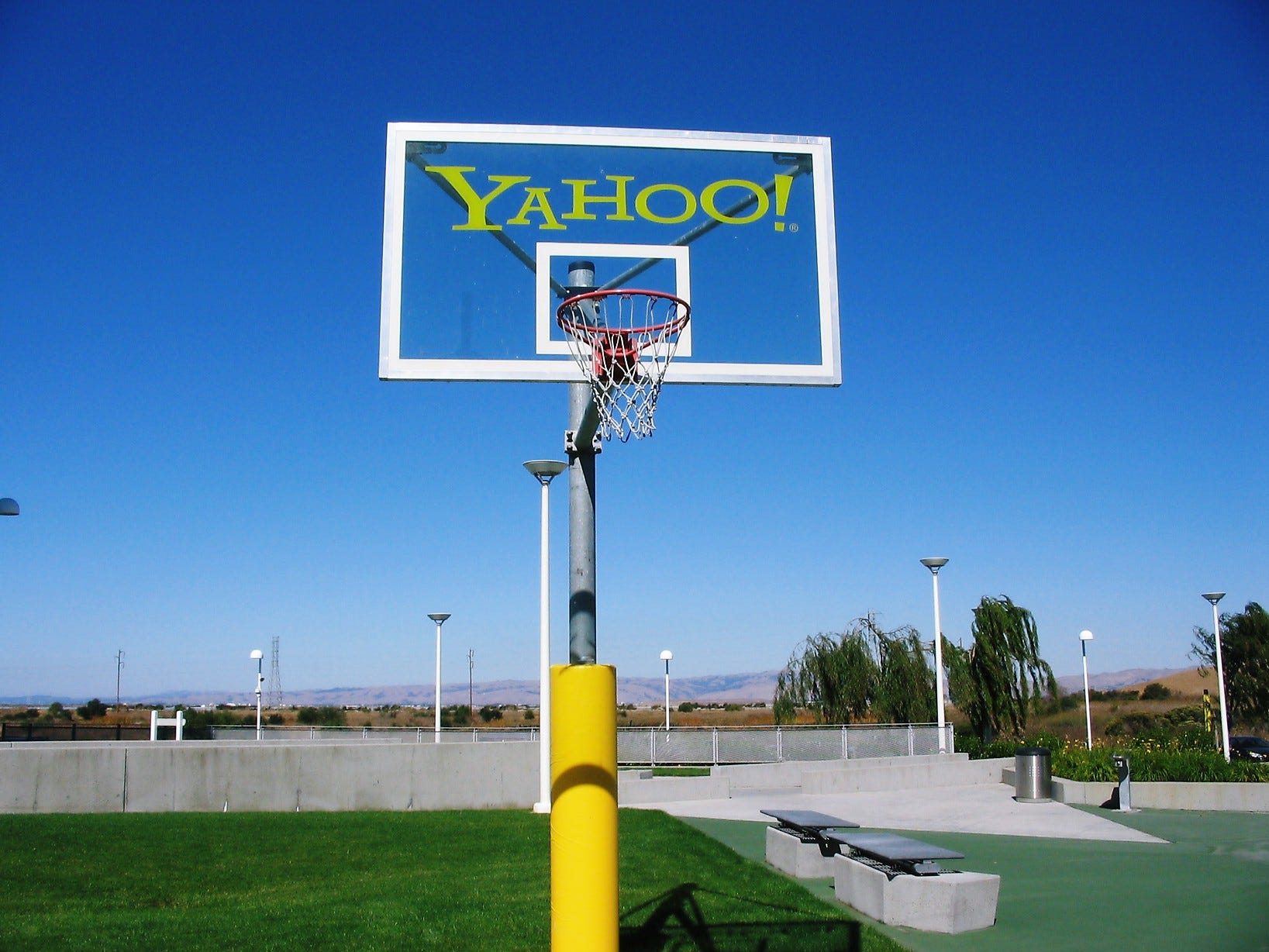
In 2005, I could easily imagine myself playing hoops in Sunnyvale, CA.
Inside, there were game rooms and a fitness center. Distinguishing this campus from similar ones in Silicon Valley, like Google’s and Apple’s, was its bright yellow and purple markings around the grounds. What especially stood out to me was a large yellow, rectangular edifice that encased the entrance to the cafeteria — it was like a giant lego block with a chunk cut out of it. There were no markings on this thing, although in later years it would be re-painted purple and a giant white Yahoo logo added.
We walked into the reception, where there was a computer set up for visitor check-in. On the desk were a small bowl of Yahoo-branded mints and a couple of bottles of water. After entering my details, a “Yahoo! Passport” visitor sticker emerged out of a little machine and I put it onto my polo shirt: “Richard MacManus, http://readwriteweb.com” it read, with the “m” of the dot com trailing onto the second line.
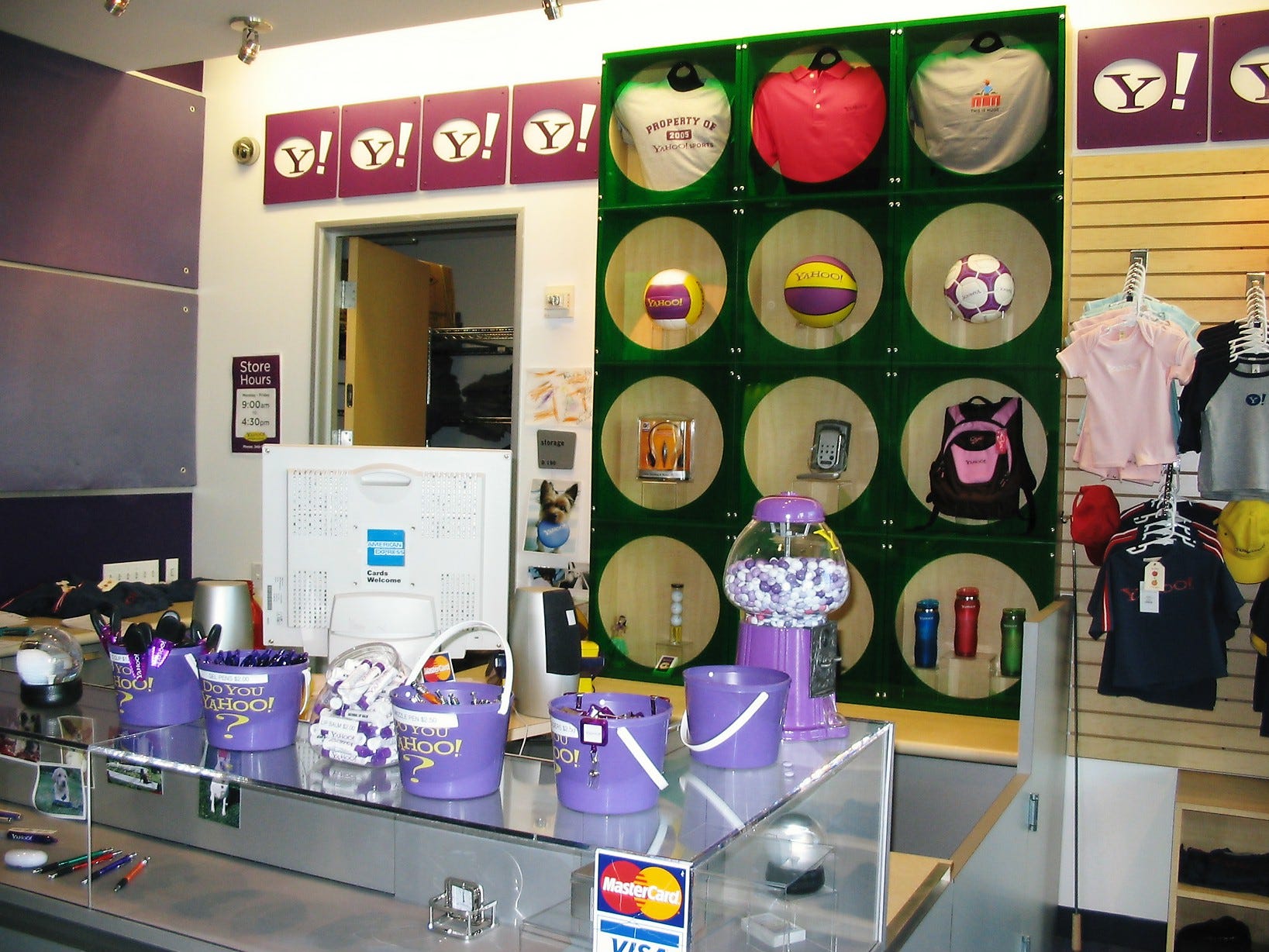
Yahoo! merch.
Havi then led me upstairs and down some corridors, and we entered one of the office areas. It was a familiar open office setup — there were rows of cream-colored cubicle desks, each containing two people. Dividing boards painted bright yellow with a purple sash bisected the desks and there were two yellow stars on the side of each divider, listing the names of the people who worked there. On the desks were the usual things: open laptops, desktop computers with hardware towers (there was even the odd beige-colored 1990s monitor with a huge carcass), dark grey mice and office telephones. The room itself looked new, but otherwise it was not that different to the office environment I was familiar with in New Zealand.
The people at their desks looked happy and were chattering among themselves as we walked through. I spotted remnants of a recent nerf gun fight, with purple-and-yellow foam nerfs scattered around the office. Soon we arrived at the desk of a guy who looked about my age. He had well-cropped dark hair and was wearing a mid-blue button-down shirt and dark blue slacks. With his clean-shaven tanned face and gleaming white teeth, he reminded me a little of Tom Cruise.
“Richard, this is Scott Gatz,” said Havi. Scott stood up and shook my hand, smiling broadly. I probably said something like, “great to put a face to the name,” since Scott was the first Yahoo employee I’d interacted with over email. He was responsible for the ‘My Yahoo!’ portal and in our early interactions he’d referred to himself as “the RSS guy at Yahoo.”
Scott led me to a nearby meeting room and we talked about a possible job for me at Yahoo. I had a tendency, common amongst New Zealanders, to downplay my previous work experience — before I was a blogger, I’d been a webmaster and then “Web Manager” at a couple of local corporations. An American doing the same work as a young professional would probably list their job title as “Vice-President of Web Operations” on their resume, but I was incapable of talking myself up in that way. Scott seemed to understand this about me, and assured me that it wasn’t a matter of will I work here, but what’s the right role for me.

There were several active Yahoo! bloggers at this time, including Scott Gatz.
Later in the morning, Havi introduced me to another Yahoo employee I’d become familiar with online, although we’d never emailed. Jeremy Zawodny was known in the blogosphere as Yahoo’s resident tech blogger; he was a developer, perhaps a couple of years older than me, who had been at Yahoo for nearly six years and had written a tech book for O’Reilly Media, entitled “High Performance MySQL.”
Jeremy had thinning dark brown hair and wore a pair of thin, oval glasses over his clean-shaven face. He was dressed casually, in a charcoal shirt and blue jeans, but his gaze was sharp and his expression almost smug. Not in a bad way, he just had that air of self-confidence that the best software engineers effortlessly carry around with them — particularly, I was learning, if they work in a large Silicon Valley company.
He suggested we head over to the cafeteria opposite for coffee, so we made our way out of the office building. It was a lovely, cloudless autumn day and the sun was now streaming down. As we walked across the clean concrete pathway towards the yellow edifice atop the cafeteria, Jeremy explained that 25-33% of his job now was blogging (I wouldn’t have been surprised if he’d developed a software program to calculate that every week). About a year or two ago, he continued, senior managers in the company — including Yahoo co-founder David Filo — had begun complimenting him on his blog and telling him to “keep doing what you’re doing.” Now, Yahoo was getting into blogging in a big way, he said, noting that Scott Gatz had just started one.
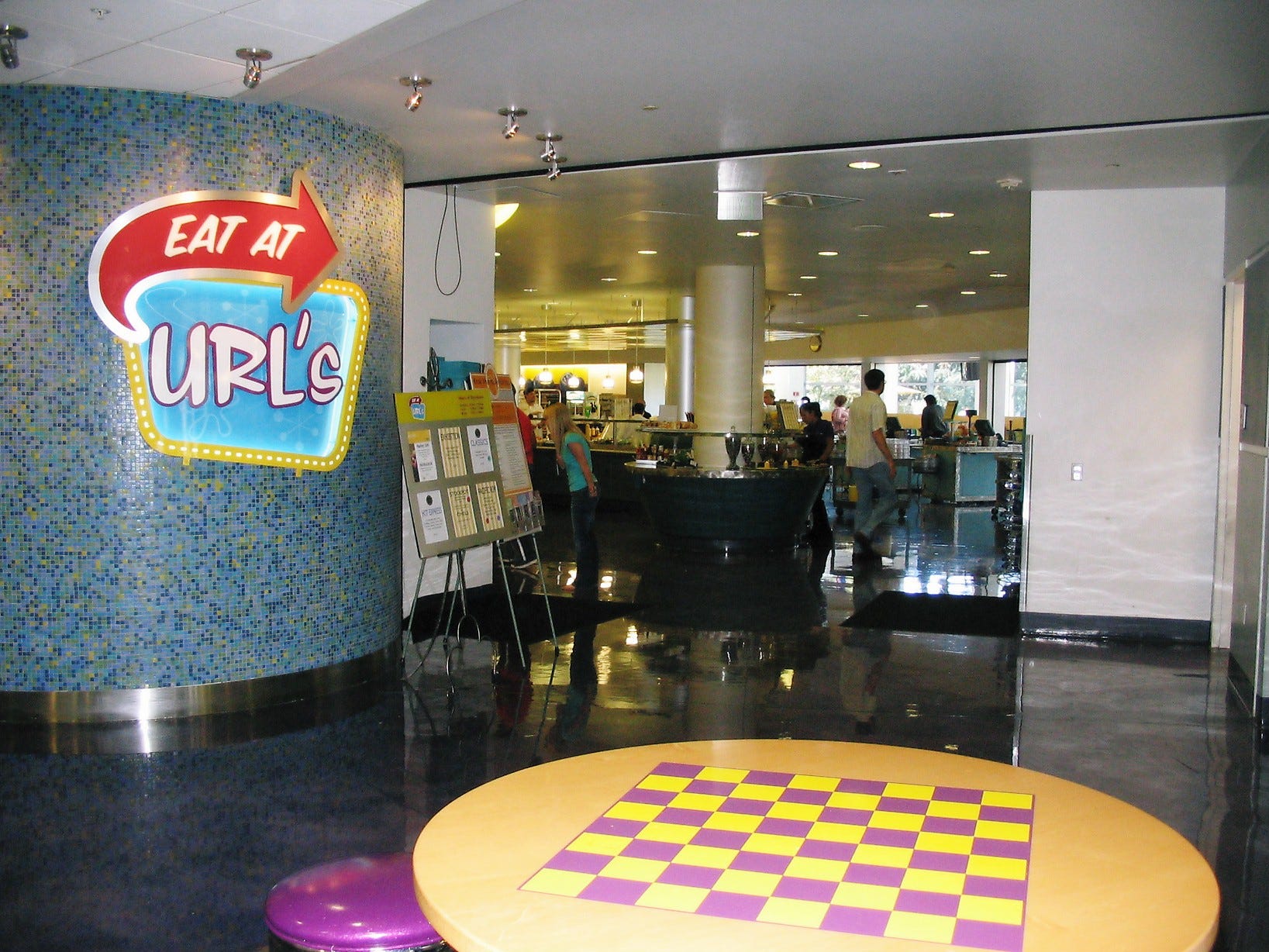
The Yahoo! cafetaria, URL’s, on the day I visited.
We entered the cafeteria, called URL’s, and I had another n00b moment as I cast my eyes around this large, modern eatery. It felt cavernous and new — the ceiling was very high, with silver lighting and air conditioning pipes running across the top of the building. Flags from around the world were hung from the ceiling. Since it was before lunchtime, the cafeteria wasn’t too busy, so we walked up to one of the baristas and ordered coffee. “It’s all free here,” Jeremy said, noticing my hesitant expression. I almost felt obliged to take advantage, so along with my cappuccino I got a drink out of one of the refrigerators — I chose a bottle of Vitaminwater, a brand I’d been enjoying during my stay in the US.
I followed Jeremy over to one of the grey rectangular tables and sat down in a yellow seat. We talked some more about the blogging and RSS scene. After a while, Jeremy took out his cell phone — a Motorola V710 flip phone with 1 megapixel camera — and snapped a photo of me. It’s still on Flickr today and is a nice snapshot of me at that time: I was wearing a striped blue polo shirt and thin oval glasses (not unlike Jeremy’s), and my fine hair was carefully swept to one side. I’m overweight, so my face is somewhat puffy, but I look happy — if also a little overawed.
When he posted the photo later, Jeremy used my name as the title and added the caption, “Of ReadWriteWeb fame…” Although “fame” was overstating it, I did feel like I had a profile during that first trip to Silicon Valley — and that meeting people like Jeremy was helping to raise it even more.

Inside the Yahoo! cafe.
During our conversation, Jeremy was a little dismissive of Yahoo’s competitors. He claimed that Google “wants to be Yahoo 2.0” and that Microsoft was slow but had enough money to get away with it. He wasn’t wrong that Yahoo had taken the early initiative in Web 2.0 — as well as acquiring Flickr in March, it had quickly integrated RSS across its suite of products: news, mobile, email and podcasts. But he was underestimating the other big companies. Google had just released Google Reader that month (it would become the leading RSS Reader the following year). It had also continued its run of impressive Ajax-based web products with Google Maps, which launched in February. Microsoft, unsurprisingly, was the slowest of the bigcos to embrace the new web revolution — but in November it went all-in on Web 2.0 with “Microsoft Live,” the brand name for its new “software as a service” strategy.

Google Reader was released during the Web 2.0 Conference; photo by Kars Alfrink.
We also talked that morning about blogs becoming mainstream, which was part of Yahoo’s strategy for employees like Jeremy, Scott and Havi. “The features that make blogs what they are (on-page discussion, chronological sorting, generous linking) will work themselves into ‘non-blog’ sites more and more in the coming months,” Jeremy wrote in a post the day after meeting me.
In hindsight, he was only partially right — blogs and RSS eventually gave way to social media and feeds. And of course Yahoo was soon eclipsed as a platform for those things by both Google and Microsoft (as well as Apple, Facebook and Amazon). But it was also true that, in 2005, bloggers were the flag-bearers of the new social web. We were, as Jeremy put it in the same post (albeit in sarcastic air quotes), “special.” The fact I’d been invited to the Yahoo campus at all signaled that I was at the forefront of a movement — and perhaps on my way becoming a Silicon Valley insider.
Lead image: Me at the Yahoo! campus, 10 October 2005; photo by Jeremy Zawodny.
This post is part of my serialized book, Bubble Blog: From Outsider to Insider in Silicon Valley’s Web 2.0 Revolution. View table of contents.
Next up: 010. Spicy Noodles
You're reading Cybercultural, an internet history newsletter. Subscribe for free, or purchase a premium subscription. Your support for this indie publication would be greatly appreciated.